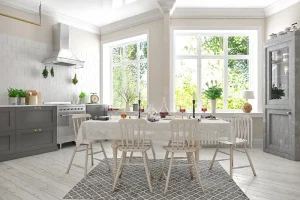Eco-friendly kitchen remodeling is more than just a design trend; it’s a sustainable lifestyle choice that focuses on reducing environmental impact while creating a functional, aesthetically pleasing space. As homeowners become more conscious of their ecological footprint, the demand for energy-efficient appliances, sustainable materials, and waste-reducing strategies has surged. By making conscious choices—from incorporating reclaimed wood to opting for ENERGY STAR-rated appliances—homeowners can craft a kitchen that not only enhances their living space but also contributes positively to the environment. This approach to remodeling blends modern design with sustainability, ensuring that your kitchen is a reflection of both your style and your values.
Key Takeaways
- Choose sustainable materials like reclaimed wood and bamboo to reduce your ecological footprint and enhance aesthetic appeal.
- Invest in ENERGY STAR-rated appliances to improve energy efficiency and lower your utility bills.
- Maximize natural lighting in your kitchen design to decrease reliance on artificial lighting and enhance ambiance.
- Incorporate water-conserving fixtures to promote resource efficiency and contribute to a sustainable lifestyle.
- Implement waste reduction strategies, such as recycling and composting, to minimize landfill contributions during your remodeling project.
Understanding Eco-Friendly Remodeling
Understanding eco-friendly remodeling begins with recognizing its impact on both the environment and your home. This approach transcends mere aesthetic upgrades; it embodies a commitment to sustainability, efficiency, and health. By prioritizing eco-friendly kitchen remodeling tips, homeowners can considerably reduce their ecological footprint while creating a space that fosters well-being and community.
Central to this philosophy is the conscientious selection of materials and processes. Utilizing reclaimed wood, low-VOC paints, and energy-efficient appliances not only minimizes waste but also enhances indoor air quality. Additionally, the incorporation of natural lighting and proper insulation can lead to considerable energy savings, making your kitchen a model of efficiency.
It is vital to engage with local suppliers and artisans who share a commitment to sustainability. This strengthens community ties and guarantees that your remodeling project supports the local economy. In addition, involving your family in the decision-making process can foster a sense of belonging and shared responsibility for the environment.
Ultimately, eco-friendly remodeling is about creating a home that reflects your values, promotes sustainability, and fosters a sense of community. By embracing these principles, you can transform your kitchen into a sanctuary of eco-conscious living.
Benefits of Sustainable Materials
In the domain of eco-friendly kitchen remodeling, the choice of materials plays a pivotal role in achieving sustainability and aesthetic appeal. Sustainable materials, such as reclaimed wood, bamboo, and recycled metal or glass, offer numerous benefits that resonate deeply with environmentally conscious homeowners.
Firstly, these materials greatly reduce the ecological footprint of your kitchen remodel. By utilizing resources that are renewable or repurposed, you minimize waste and the demand for new raw materials. This practice not only conserves natural resources but also fosters a circular economy.
Secondly, sustainable materials often boast superior durability and longevity. For instance, bamboo is renowned for its strength and resistance to moisture, making it an excellent choice for flooring and cabinetry. This durability translates into fewer replacements over time, further benefiting both the environment and your wallet.
Lastly, embracing sustainable materials enhances your home’s overall aesthetic. These elements often carry unique textures and colors, providing a distinctive charm that fosters a sense of belonging and connection to nature. Overall, incorporating sustainable materials in your eco-friendly kitchen remodeling not only elevates your space but also contributes to a healthier planet and community.
Energy-Efficient Appliances
While a kitchen remodel can greatly enhance a home’s functionality and aesthetic appeal, integrating energy-efficient appliances is essential for achieving eco-friendly kitchen remodeling. These appliances not only reduce energy consumption but also contribute to a sustainable lifestyle, helping homeowners minimize their carbon footprint.
When selecting energy-efficient appliances, consider the following key features:
- ENERGY STAR Certification: Look for appliances that meet this standard, ensuring peak energy efficiency.
- Smart Technology: Utilize appliances that can be programmed or controlled remotely, allowing for better energy management.
- Size Appropriateness: Choose appliances that fit your cooking and storage needs without excess capacity, which can waste energy.
- Durability and Repairability: Opt for brands known for longevity and easy repair options, reducing waste and the need for replacement.
Waste Reduction Strategies
Implementing effective waste reduction strategies can greatly enhance the sustainability of your kitchen remodel. One innovative approach is to prioritize the use of reclaimed and recycled materials. By selecting countertops made from recycled glass or cabinets crafted from reclaimed wood, you not only minimize waste but also create a unique aesthetic that tells a story.

Another practical strategy is to assess your existing kitchen components before initiating a remodel. Rather than discarding appliances, fixtures, or cabinetry, consider refurbishing or repurposing them. This not only reduces landfill contributions but also saves you money. For instance, repainting old cabinets can breathe new life into your kitchen without the need for new materials.
Additionally, implementing a robust recycling and composting system in your kitchen can considerably decrease waste. Designate specific bins for recyclables and organic waste to encourage responsible disposal practices. Finally, when planning your kitchen layout, aim for a design that promotes efficient food preparation and storage, ultimately reducing food waste.
Tips for a Green Design
Creating a green design for your kitchen remodel involves a thoughtful approach that balances aesthetics with sustainability. As you initiate this transformative journey, consider these eco-friendly kitchen remodeling tips that foster a sense of belonging within your home while protecting the planet.
- Select Sustainable Materials: Opt for reclaimed wood, bamboo, or recycled materials to create an inviting and durable space.
- Energy-Efficient Appliances: Invest in Energy Star-rated appliances that consume less energy, thereby reducing your utility bills and carbon footprint.
- Natural Lighting: Maximize natural light with strategically placed windows or skylights, reducing the need for artificial lighting and creating a warm atmosphere.
- Water-Conserving Fixtures: Choose faucets and fixtures designed for water efficiency, ensuring that your kitchen is not only beautiful but also conserves precious resources.
Frequently Asked Questions
What Are the Costs Associated With Eco-Friendly Kitchen Remodeling?
The costs associated with eco-friendly kitchen remodeling can vary greatly based on materials, appliances, and design choices. Investing in sustainable options may initially be higher but often leads to long-term savings and environmental benefits.
How Can I Find Certified Green Contractors?
To find certified green contractors, utilize online directories like the Green Business Bureau, check local trade organizations, and seek recommendations from eco-conscious communities. Ascertain contractors possess certifications in sustainable practices and experience in green building techniques.
Are There Eco-Friendly Options for Kitchen Flooring?
Yes, there are several eco-friendly options for kitchen flooring, including bamboo, reclaimed wood, cork, and linoleum. These materials are sustainable, durable, and can enhance aesthetic appeal while minimizing environmental impact in your kitchen space.
Can I Incorporate Smart Technology in an Eco-Friendly Remodel?
Integrating smart technology into an eco-friendly remodel enhances efficiency and sustainability. Consider energy-efficient appliances, smart lighting, and automated systems to optimize resource use, reduce waste, and create a modern, environmentally conscious kitchen environment that fosters community.
What Are the Best Plants for Improving Kitchen Air Quality?
Incorporating plants such as spider plants, peace lilies, and pothos can greatly enhance kitchen air quality. These species are not only aesthetically pleasing but also effective in filtering toxins, promoting a healthier cooking environment.
Conclusion
To sum up, eco-friendly kitchen remodeling represents a pivotal approach to creating sustainable living environments. By integrating sustainable materials, energy-efficient appliances, and strategic design practices, homeowners can greatly reduce their ecological footprint while enhancing the aesthetic appeal of their kitchens. Emphasizing waste reduction and resource efficiency not only contributes to environmental preservation but also fosters healthier living spaces. Ultimately, adopting these practices reflects a commitment to sustainability that benefits both individual households and the broader community.
You May Also Like To Read:


